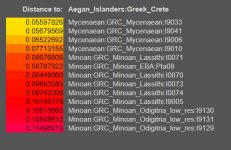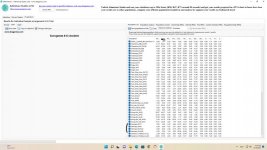Kari
Regular Member
- Messages
- 274
- Reaction score
- 70
- Points
- 28
- Location
- Lamia
- Ethnic group
- Sarakatsani,Pontic Greek
- Y-DNA haplogroup
- I2a
This is a thread about the ancestry of cretans.We can easily detect the slavic ancestry by seeing the 9,5% of baltic admixture in modern cretans.Yamnaya's had 0% of baltic admixture so we are like 85% sure that ancient greeks had not baltic admixture.We can detect some asian ancestry(2-7%) because they have higher West_Asian admixture than the rest greek population.Source:https://docs.google.com/spreadsheets/d/1-CqRbvWntX1Xgz4fRkDIng7r6-hOxA2PbmL4gDJHfgg/edit#gid=0
Now we will see the k12b averages of 2 ancient greek samples and modern cretans.
Gedrosia:6.88}{8.02
Siberian:0.00}{0.02
NW_African:3.78}{2.63
SE_Asian:0.50}{0.20
Atlantic_Med:27.23}{23.40
North_European:11.24}{12.24
South_Asian:0.00}{0.17
East_African:0.22}{0.23
SW_Asian:13.20}{14.43
East_Asian:0.00}{0.17
Caucasus:36.92}{38.45
SSA:0.01}{0.04
As we can see modern cretans are very close to ancient greeks.
Left:Ancient Greek samples.source:https://www.eupedia.com/genetics/ancient_italy.shtml
Right:modern cretans.source:https://docs.google.com/spreadsheet...CEMESjkJpG78ARtrxwwtbt52c/edit#gid=1797482804
Its safe to say that modern cretans have something like 60-75% greek dna

Source about the yamnaya's zero baltic admixture:

Now we will see the k12b averages of 2 ancient greek samples and modern cretans.
Gedrosia:6.88}{8.02
Siberian:0.00}{0.02
NW_African:3.78}{2.63
SE_Asian:0.50}{0.20
Atlantic_Med:27.23}{23.40
North_European:11.24}{12.24
South_Asian:0.00}{0.17
East_African:0.22}{0.23
SW_Asian:13.20}{14.43
East_Asian:0.00}{0.17
Caucasus:36.92}{38.45
SSA:0.01}{0.04
As we can see modern cretans are very close to ancient greeks.
Left:Ancient Greek samples.source:https://www.eupedia.com/genetics/ancient_italy.shtml
Right:modern cretans.source:https://docs.google.com/spreadsheet...CEMESjkJpG78ARtrxwwtbt52c/edit#gid=1797482804
Its safe to say that modern cretans have something like 60-75% greek dna

Source about the yamnaya's zero baltic admixture:



